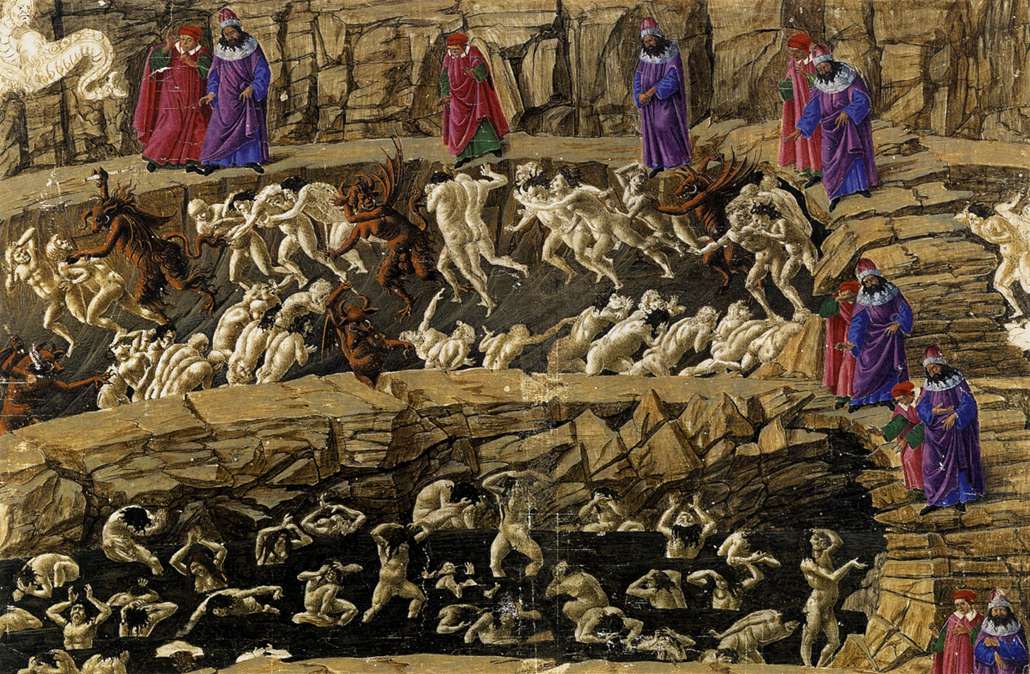
Through me one goes into the sorrowful city,
through me one goes into eternal grief,
through me one goes among the lost people.
Justice moved my high creator;
divine power made me,
and highest knowledge and the first love.
Before me no thing was created
that was not eternal, and I endure eternally.
Leave behind all hope, you who enter.[1]
Through the halls of time, you will not find a more haunting, surreal, and exhilarating vision than Dante’s Divine Comedy. The poem’s eerie and dreamy account retells the epic journey of Dante Alighieri though hell, purgatory, and heaven. His after-worldview, written over 700 years ago, unceasingly intrigues and inspires readers and artists today. My favorite artistic renditions flow from the brush of Salvador Dali and William Blake. Each produced 100 paintings, one for each canto, a legacy of this enduring classic. The work merits reading and study from a variety of disciplines, including theology, philosophy, cultural history, literary criticism, and aesthetics.
Called a comedy due to Dante’s fortuitous outcome, the work embodies unrivaled cultural synthesis where the Greco-Roman and the Hebreo-Christian cultures flow together, reaching a pinnacle of interplay. In the High Middle Ages, Thomas Aquinas’s Summa Theologica also synthesized theology and philosophy. Both Dante and Aquinas shine as twin morningstars of the soon dawning Italian Renaissance.
The Comedy contains the Inferno, Purgatorio, and Paradiso. In the Inferno, Dante follows Virgil, the greatest Roman poet, from the top to the bottom of an underworld hell. Along the weary path down, they pass through descending circles that contain the souls of people who died outside of Christ’s redemptive work. Each circle portrays some sin and its insidious evil effects on the soul. Dante employs the principle of contrapasso. Each forlorn sinner willingly embraces the destructive vice, filth, excrement, violence, and lust that destroys and degrades their soul. Thus, the vices they choose over Christ’s virtues transmogrify into the tool of punishment that they greedily embrace. Vice is its own punishment, virtue its own reward. Sinners are not imprisoned rather they imprison themselves. They choose to stay and decay in vice. There’s no divine grace here, as the gates of hell say, “Abandon all hope, ye who enter here.” Ever the master of poetic justice, Dante’s evocative and graphic descriptions need no high-tech CGI or movie special effects. You will choke on the stench as he unveils the ugliness of sin.
Passing through the lowest regions of hell where Satan abides, Dante and Virgil escape to the surface of the earth at Mount Purgatory, the antipode of holy Jerusalem. Through seven levels, each corresponding to the seven deadly sins, sinners purge their souls of their false love and adoration of that vice. A wrathful person might take thousands of years to overcome that level and move up the mountain. Eventually sinners reach the top, an Earthly Paradise where they will soon enter the third division, Heaven (Paradiso).
Virgil, the personification of human reason, must transfer care of Dante to Beatrice, the personification of grace. The pagan Virgil can’t enter heaven and must return to hell. No one escapes hell (except Dante for literary purposes). Entering Paradiso, Dante ascends through luminous spheres, corresponding to the spheres of the planets and the stars. Remember, this is a pre-Copernican view of the universe. The brilliant orbs of glory and exhilaration contain the redeemed, the holy, martyrs, and saints. Each sphere more brilliant and crystalline in purity stretches Dante’s poetry to the uttermost limit of human language. The sublimity elevates you to ethereal visions and feelings you may never have experienced. [Plot spoiler warning] Ascending the highest spheres, Dante encounters the Apostles, Moses, Abraham, and Mary. Finally, he beholds the beatific vision of God.
Dante’s striking work rewards readers with an imaginary afterworld unparalleled in scope or description by any poet, save Milton’s Paradise Lost. Only the Apostle John’s Apocalypse in Scripture exceeds their visionary power of the spiritual world. Read John Ciardi’s translation for the greatest effect and clarity. I suggest reading two or three cantos a day. This cornerstone of world literature will leave you musing for years.

